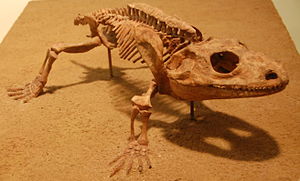Cacops
| Cacops | ||||||||||||
|---|---|---|---|---|---|---|---|---|---|---|---|---|

Skeletal reconstruction from the Cacops in the Field Museum of Natural History |
||||||||||||
| Temporal occurrence | ||||||||||||
| Unterperm | ||||||||||||
| 274 to 271 million years | ||||||||||||
| Locations | ||||||||||||
| Systematics | ||||||||||||
|
||||||||||||
| Scientific name | ||||||||||||
| Cacops | ||||||||||||
| Williston , 1910 | ||||||||||||
| species | ||||||||||||
|
Cacops is an extinct genus of terrestrial vertebrates from the Temnospondyli group . Their fossil remains, which aremore than 270 million years old, were found in the USA in deposits of Unterperm . The type species , Cacops aspidephorus , wasdescribedby Samuel Wendell Williston in 1910, another species, Cacops morrisi , was described by Reisz et al in 2009 .
Description and paleobiology
Cacops reached a length of 40 cm. His physique shows clear signs that, in contrast to many other Temnospondyles, he was strongly adapted to a terrestrial way of life. The skull was massive, the jaw margins were covered with long fangs and the palate with thousands of small, cusp-like denticles. The legs were strong, the tail was short. Cacops had a series of bone plates on his back that were embedded in the skin. Compared to other dissorophids, Cacops had a relatively large ear slit (Squamosal Bay) in the rear edge of the skull. The size of this structure and a fine stripe along its outer edge prove that Cacops had an eardrum , which at the time of the description is the oldest clear evidence of an eardrum in the fossil record .
Edwin Colbert suspected that Cacops was nocturnal , similar to today's frogs .
Systematics
Cacops was a member of the Dissorophidae family . Its closest relative is Kamacops ; both are combined to form the subfamily Cacopinae . Another close relative could be Aspidosaurus . The sister taxon of the Cacopinae is the subfamily Dissorophinae with the genera Dissorophus and Broiliellus . The closer relationship between Cacops and other dissorophids is shown in the following cladogram (according to Reisz et al. , 2009):
| Dissorophoidea |
|
||||||||||||||||||||||||||||||||||||||||||
|
|
swell
- Edwin H. Colbert : Evolution of the Vertebrates , John Wiley & Sons Inc (2nd ed.), 1969
supporting documents
- ↑ a b R.R. Reisz, Schoch, RR; and Anderson, JS: The armored dissorophid Cacops from the Early Permian of Oklahoma and the exploitation of the terrestrial realm by amphibians . In: Natural Sciences . 96, No. 7, 2009, pp. 789-796. doi : 10.1007 / s00114-009-0533-x .
- ↑ BM Gee et al. 2017. Histological characterization of denticulate palatal plates in an Early Permian dissorophoid. PeerJ 5: e3727; doi: 10.7717 / peerj.3727
- ↑ Jason S. Anderson, Amy C. Henrici, Stuart S. Sumida, Thomas Martens, and David S. Berman: Georgenthalia clavinasica, A New Genus and Species of Dissorophoid Temnospondyl from the Early Permian of Germany, and the Relationships of the Family Amphibamidae . In: Journal of Vertebrate Paleontology . 28, No. 1, 2008, pp. 61-75. doi : 10.1671 / 0272-4634 (2008) 28 [61: GCANGA] 2.0.CO; 2 .

